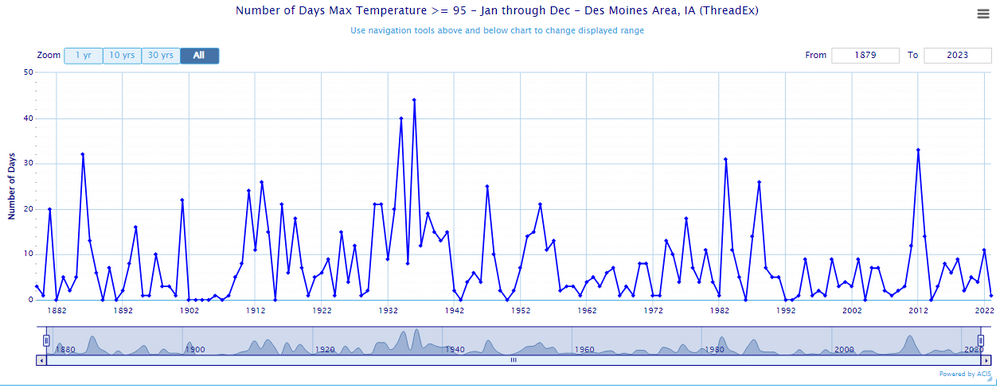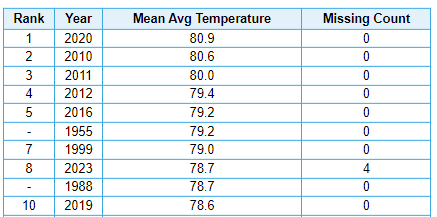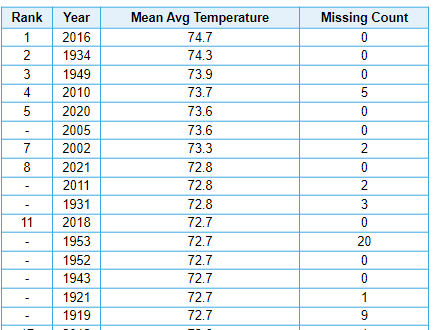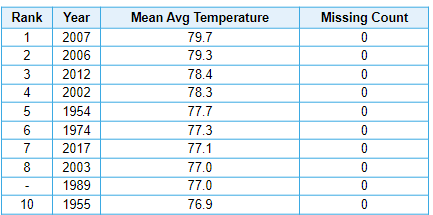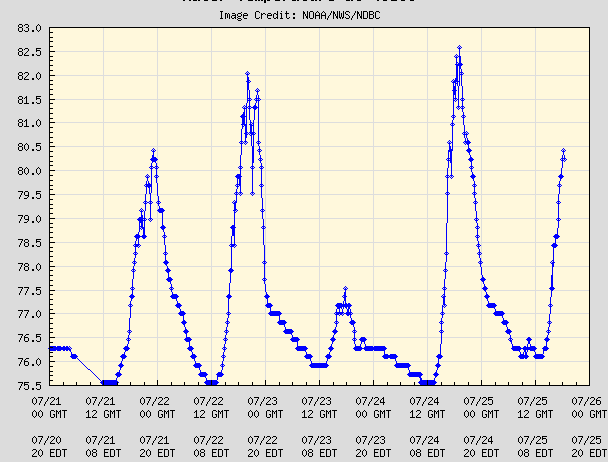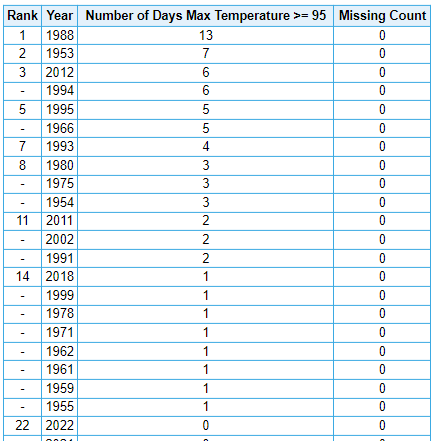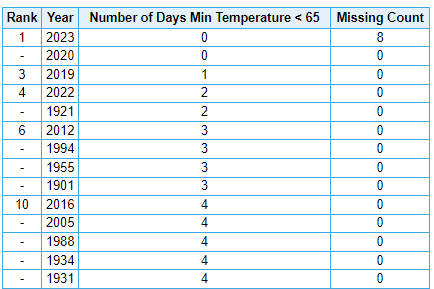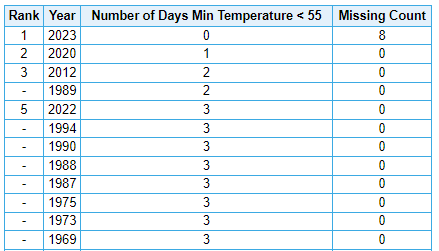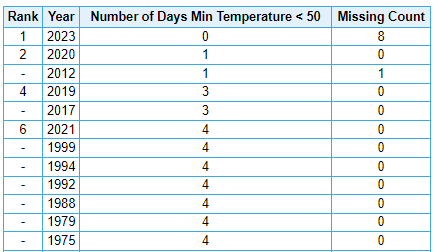
TheClimateChanger
Members-
Posts
4,077 -
Joined
-
Last visited
Content Type
Profiles
Blogs
Forums
American Weather
Media Demo
Store
Gallery
Everything posted by TheClimateChanger
-
The use of data from Cedar Rapids also makes the trend look more pronounced. Cedar Rapids is often one of the cooler spots in the state of Iowa. The early records have an unbelievable number of days of 95+. It's not believable that Cedar Rapids would have experienced more days of 95+ than Des Moines in those years. That makes no sense climatologically. The data for Des Moines also show a trend towards less, but not nearly that pronounced.
-
No, because what these reports never tell you is the concomitant increase in dewpoints from the anthropogenically enhanced transpiration. Peoria, Illinois, for instance, had a heat index of 104F at 1 am. Some of these areas will likely see wet bulb temperatures approach the theoretical limits of human survivability later this century. Not to mention the devestation wrought on native plants and animals, which have evolved to live in a drier climate with periodic heat extremes.
-
Impressive heat this month. Hagerstown is up to 8th place all-time. I like to use Hagerstown, since it's outside of the Baltimore-Washington urban heat island. Incredibly, 7 of the top 10 hottest Julys have occurred since 2010. Excluding years on or after 2010, this month would place in third place, just behind the hot Julys of 1955 and 1999, and tying 1988. By comparison, the "so-called" hottest July on record in 1936 saw a mean temperature of 73.8F. Excluding a 7-day heat wave that month [July 9-15], the mean for the other 24 days was an incredibly comfortable, summer of yesteryear-esque 71.4F.
-
Heat wave uncancelled with a high of 91 in Spartmanland. A few clouds were no match for Old Man Summer.
-
Pittsburgh/Western PA Summer 2023
TheClimateChanger replied to Ahoff's topic in Upstate New York/Pennsylvania
For nearby Wheeling - Ohio County Airport, there have only been 17 hours of 100+ heat indices dating since 2013. What's weird is this hasn't even been a stretch of unusually cool summers, but rather a stretch that has included some of the hottest summers in Wheeling weather history, including the hottest (2016), 5th hottest (2020), 8th hottest (2021), and 11th hottest (2018) on record. -
Pittsburgh/Western PA Summer 2023
TheClimateChanger replied to Ahoff's topic in Upstate New York/Pennsylvania
-
It looks like coastal regions in general are warming faster than continental interiors, with extreme marine heatwaves present near multiple coastlines driving intense surface air warming. Perhaps the models are simply incorrect, and coastal regions experience more warming from an enhanced greenhouse than do continental interiors? You can even see that same effect in the Alaskan inset, with a relative minimum of warming in the Alaskan interior and enhanced warming along all of the coastlines.
-
Also, I would expect Rapid City's ranking to climb well out of the top ten with the ongoing heat wave. Already up to 88 as of 9:50-ish a.m. local time. Looks like it may reach 100 there today. And upon further review, looks like Rapid City's warmest Julys are dominated by years in the past couple of decades. So not much evidence of a cooling trend.
-
Looks like there is a pretty strong relationship between El Nino conditions and cool Julys at Rapid City. Not sure about the corn effect though. Looks like the coldest anomalies are west of the Corn Belt this year. In fact, I don't think Rapid City or surroundings have a significant cropland presence for that matter. Edit: Also suspect the omnipresent Canadian wildfire smoke and haze has assisted in the cool anomalies across the northern Plains this summer by filtering the sunlight. While we have had some outbreaks of smoke in the Great Lakes and northeast, the northern Plains has been ground zero for a lot of the smoke.
-
Report: Another Year of Record Heat for the Oceans
TheClimateChanger replied to donsutherland1's topic in Climate Change
17 years at Caribou (since records began in 1939) have had monthly mean temperatures less than or equal to the current monthly minimum average for 2023. -
Report: Another Year of Record Heat for the Oceans
TheClimateChanger replied to donsutherland1's topic in Climate Change
Clearly, the Caribou lows are being elevated by the runaway urban heat island effect and non-existent jet traffic there. -
Pittsburgh/Western PA Summer 2023
TheClimateChanger replied to Ahoff's topic in Upstate New York/Pennsylvania
Fairbanks, Alaska has had as many 90-degree days as us this summer: National Weather Service : Observed Weather for past 3 Days : Fairbanks, Fairbanks International Airport -
Occasional Thoughts on Climate Change
TheClimateChanger replied to donsutherland1's topic in Climate Change
https://www.cnn.com/videos/world/2023/07/25/exp-climate-crisis-disaster-eliot-jacobson-vause-intv-07251aseg1-cnni-world.cnn -
Wonder if we'll see some 90+ degree buoy readings on Lake Erie with the upcoming heat wave? Doesn't look like we'll be seeing those 101 degree SSTs they had off Key Largo, Florida, but 90 degrees is certainly a distinct possibility. 1 m water temperature up to 80 at the Toledo Crib. Reached 83 yesterday afternoon. Probably a decent chance of reaching into the 90s there in the coming days. Source: NDBC - Station 45165 Recent Data (noaa.gov)
-
Occasional Thoughts on Climate Change
TheClimateChanger replied to donsutherland1's topic in Climate Change
-
Occasional Thoughts on Climate Change
TheClimateChanger replied to donsutherland1's topic in Climate Change
Fortunately, it is mostly a myth that Europe is warmed by the Gulf Stream. In fact, the relative winter warmth is driven principally by stationary waves in the atmospheric flow driven by the Rocky Mountains in North America, and the atmospheric transport of heat released by the oceans that had been stored in the summertime. Actual oceanic heat transfer is only a minor contributor. Warming from rising greenhouse gases would probably exceed any cooling from an AMOC collapse. You have to be skeptical of a paper that predicts a colder future for Europe, when it contradicts our existing knowledge. See: The Gulf Stream Myth (columbia.edu) The Gulf Stream and future climate change A slowdown of the Gulf Stream and ocean circulation in the future, induced by freshening of the waters caused by anthropogenic climate change (via melting glaciers and increased water vapor transport into high latitudes) or simply by warming, would thus introduce a modest cooling tendency. This would leave the temperature contrast across the Atlantic unchanged and not plunge Europe back into the ice age or anything like it. In fact the cooling tendency would probably be overwhelmed by the direct radiatively-driven warming by rising greenhouse gases. -
Pittsburgh/Western PA Summer 2023
TheClimateChanger replied to Ahoff's topic in Upstate New York/Pennsylvania
Looking more closely at the data, there are 69 days of 95+ in 71 years, which is an average of just under 1 per year. However, those 69 days were spread across only 21 years, meaning the actual incidence of a 95 or better reading is only roughly 2 out of each 7 years. It is much more common not to reach 95 than it is to reach that value. Using historical averages, approximately 5 out of every 7 years would be expected to reach no more than 94 degrees. In years in which it reaches at least 95 degrees, it is much more likely than not to reach that value multiple times. Of the 21 years in which 95 or better was reached, 13 of them reached that figure on multiple occasions. Further, 8 years failed to even reach 90 - meaning it is 4x more likely that the temperature will not exceed 89 than it is to reach 100. Historically, about 1 in every 9 years at PIT fails to reach 90. There were no years between 1953 and 1975, inclusive, in which it failed to reach at least 90. The longest stretch since 1975 with no years topping out at 89 or below is 9 years, set three times - 1983 to 1991; 2005 to 2013; and 2015 to 2023. If it reaches 90 or better next year, we will be in the longest consecutive stretch with no years topping out below 90 since 1976. -
Pittsburgh/Western PA Summer 2023
TheClimateChanger replied to Ahoff's topic in Upstate New York/Pennsylvania
That's because extreme heat is exceptionally rare. There have only been 21 years since records began at Pittsburgh International Airport in September 1952, in which the mercury reached 95 or better. There have only been 2 years since records began there, in which the mercury reached or exceeded 100 degrees. Honestly, the 95+ readings in the late 1980s through mid 1990s were very likely inflated by the use of the HO-83 hygrothermometer in that era, which has a known, significant warm bias - particularly on sunny days with light winds in the warm season. So it's not suprising to find 30 of the 69 days of 95+ occurred between 1988 and 1995, in a period of about a decade or so in which that hygrothermometer model was in use. All 3 100+ readings at PIT also occurred in that era. From 1956 through 1987, a period of 32 years, there were 16 days in which the temperature reached or exceeded 95 degrees, spread across 8 years. -
Cyclical or Natural Predictable Climate Change Forum
TheClimateChanger replied to ChescoWx's topic in Climate Change
Fake news. -
No reason to expect this to continue for the rest of this century or beyond. I would expect to eventually reach a level of warming where it is no longer feasible to grow most crops in that region, which would lead to crop failures and extremely rapid warming. In such a scenario, the cooling effect would not only be reversed, but replaced by an articifial warming effect of a desert-like landscape devoid of crops. If this were to occur, parts of the midwest could see temperatures approach or exceed the all-time world record. Temperatures of 120+ have already been observed in the Dakotas, including at CO2 levels not much above 300 ppm. I don't think it's out of the question to see 130+, maybe even 140 degrees, were that same weather pattern to recur at CO2 levels of say 450-500 ppm. Even if high temperatures stay in the 110s to around 120, low temperatures may struggle to drop below 95 or 100 in the high CO2 environment. This type of warmth would dessicate and destroy all plant life in the region, leading to flash desertification. I don't know if this is an effect the models produce. But this is just thinking logically and using past weather as a guide to project what could happen in a worst-case scenario. Unfortunately, most people seem unwilling to even consider the possibility of a worst-case scenario. And instead point to the 1934 and 1936 drought and heat wave as evidence of past periods of climate tumult and assume (incorrectly) that our improved farming and soil conservation techniques will prevent that from recurring. However, it is certainly possible that the weather, in the near future, could become so harsh that there is a season where widespread crop failures occur despite our agricultural advances. If this were to occur, then you could see a recurrence of Dust Bowl conditions in a high CO2, enhanced greenhouse effect environment.
-
Central PA Summer 2023
TheClimateChanger replied to canderson's topic in Upstate New York/Pennsylvania
One of only two years (out of 136) at Harrisburg, where the minimum temperature has not dropped below 65F. -
Central PA Summer 2023
TheClimateChanger replied to canderson's topic in Upstate New York/Pennsylvania
Appears to be a good chance that this month will be the first to not have at least one low temperature below 55 at DuBois-Jefferson County Airport (dating to 1963), and one low temperature below 50 at Bradford Regional Airport (dating to 1957). While it hasn't been a super hot month, it has been consistently warm - particularly at night - leading to elevated minima. DuBois [days with minimum <55F] Bradford [days with minimum <50F]

